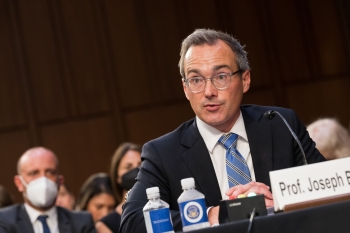Blocher testifies before Senate Judiciary Committee on public safety after Bruen
The co-director of the Duke Center for Firearms Law told legislators that judges have been given a new constitutional test for gun laws – but few guidelines on how to apply it.

Lanty L. Smith ’67 Professor of Law Joseph Blocher told the Senate Judiciary Committee that a recent Supreme Court ruling expanding Second Amendment rights will have a significant impact on efforts to protect public safety.
Blocher was one of five witnesses – and the only law professor – at the July 20 hearing titled “After the Highland Park Attack: Protecting Our Communities from Mass Shootings,” convened to consider how gun violence might be curbed following recent mass shootings at an elementary school in Uvalde, Tex., and a Fourth of July parade in Highland Park, Ill.
Blocher’s testimony included an analysis of how the Supreme Court’s June 23 ruling in New York State Rifle & Pistol Association v. Bruen will change the way courts determine whether a gun law or regulation is constitutional. Beyond striking down New York’s “may issue” gun licensing regime, the Supreme Court adopted a new test that says a gun law must have an analogue in text, history, and tradition.
The historical analogy test is a marked departure from the two-part test courts have long used, which allows them to consider whether a regulation addresses a concern, such as public safety, that overrides any infringement of individual Second Amendment rights. Following the release of the Bruen opinion, Blocher and Melvin G. Shimm Professor of Law Darrell A. H. Miller authored a critical piece for the New York Times, arguing that a purely historical approach “diminishes, if not eliminates, the relevance of the real-life costs and benefits of gun regulation.”
Blocher told legislators Wednesday that the Court offered little guidance on how lower courts should weigh competing historical comparators, which gives judges latitude to choose one that they favor.
“Properly applied, such a test should still uphold most modern gun laws, because regulation of deadly weapons is part of the common law tradition since before this nation’s founding,” Blocher said. “But the new test does open the door to an enormous amount of judicial discretion, because the Court does little to explain how we are supposed to determine whether a modern law is relevantly similar to an historical one.
“In evaluating whether those laws are ‘analogous’ to modern ones, courts will have to ask—as Bruen says—whether they are relevantly similar, especially with respect to ‘how’ and ‘why’ they burden people’s ability to have guns. And to determine whether something is relevantly similar not only permits but requires the kind of contemporary evidence that this Committee is considering today—it is simply impossible to compare modern gun laws to historical ones without evidence about the former.
“An under-specified analogical test like Bruen’s raises serious problems of administrability and invites judicial discretion and ideology to seep into decision-making.”
Blocher also noted that some gun laws protecting other constitutional rights, such as the right to shop, attend school, and vote without the fear of gun violence, may not have clear historical analogues, given the increased firing capabilities of modern firearms and the relatively recent phenomenon of frequent mass shootings. Yet they are meant to protect rights that are as important as the right to bear arms.
“Even as the Bruen majority confidently extends Second Amendment coverage to “modern instruments that facilitate armed self-defense,” it is unwilling simply to recognize the symmetric principle that the Second Amendment permits modern gun laws that facilitate public safety,” he said.
Second Amendment law going forward will be characterized by unpredictability as individual judges make their own determinations about whether historical laws are sufficiently similar or not to the ones they are considering, Blocher warned legislators.
“Legislatures can and must continue to promote public safety, including through consideration of contemporary empirical evidence,” he concluded. “Constitutional law must and will continue to reconcile history and common sense.”
Blocher is a scholar of federal and state constitutional law, the First and Second Amendments, legal history, and property. He is a sought-after media commentator on Second Amendment issues and his scholarship is widely cited, including in amicus briefs submitted in Bruen. With Miller he is faculty co-director of the Duke Center for Firearms Law and co-author of The Positive Second Amendment: Rights, Regulation, and the Future of Heller (Cambridge University Press, 2018).
On July 21 Blocher and Miller will present a webinar titled “Our Right to Bear Arms: A History of America’s Most Debated Amendment” to the United States Capitol Historical Society. The virtual event begins at noon. Registration is free and open to the public.
Read Blocher’s written testimony here.
Watch video of the hearing here (proceedings begin at 0:17:40, Blocher’s testimony begins at 1:17:32.)